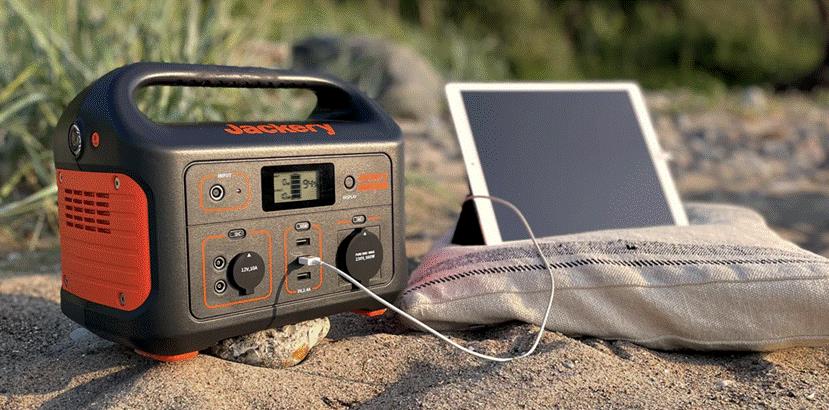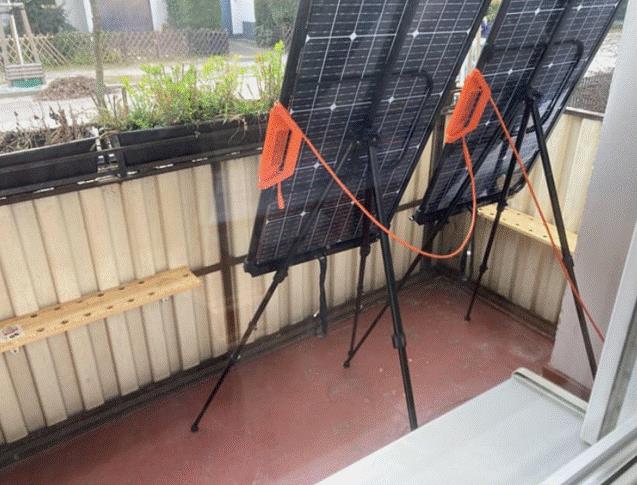In today's world, where smartphones, tablets, action cameras, and other electronic devices have become essential parts of our daily lives, our reliance on electricity has reached an unprecedented level. Especially in scenarios such as outdoor adventures, camping trips, or sudden power outages, ensuring a steady power supply for these devices has become an urgent issue. The emergence of solar-powered portable power banks offers a portable solution utilizing clean energy.
The European solar-powered portable power station market is
showing steady growth. In terms of market size, the global portable solar panel
market reached USD 1.352 billion in 2024, with Europe accounting for over 30%
of the market, contributing USD 405.66 million. In the solar-powered portable
generator sector, the regional distribution of the European market in 2025
shows significant differences, with Germany leading with a 24.50% share,
followed by the United Kingdom and Russia with shares of 17.00% and 14.30%,
respectively, while France, Italy, and Spain accounted for 8.80%, 8.20%, and
6.80%, respectively.
This article will guide you through the essence and
principles of this sun-powered energy tool from three logical perspectives:
“What is it?”, “Why is it needed?”, and “How to choose one?”
What is it: The Essence and Principles of Solar-Powered Portable Power Banks
1. Definition: What is a solar-powered portable power bank?
A solar-powered portable power bank is a portable energy
storage device integrated with solar power generation components. Its core
consists of two parts: solar panels and energy storage battery packs.
Compared to ordinary portable power banks, the biggest
difference is that it does not rely on the grid for charging—it can generate
electricity autonomously like a small “solar power station” in outdoor
environments and store the electricity to power devices such as smartphones and
flashlights.

2. Principle: How is sunlight converted into electrical energy?
The operation of a solar-powered portable power bank is
based on the photovoltaic effect: when sunlight hits the solar panels on its
surface, photons collide with the semiconductor material (typically silicon)
within the panels, causing electrons to break free from atomic bonds and form a
current. This current is direct current (DC), which is processed through
internal circuits and stored in the power bank's lithium-ion or lithium-polymer
batteries. When charging devices, the stored electrical energy is output
through USB, Type-C, or other interfaces, completing the conversion from
“sunlight” to “device power.”
3. Classification: Common types of solar-powered mobile power banks
Based on functionality and design, solar-powered mobile
power banks can be categorized into three types:
- Basic model: Features only solar charging and USB output
functionality, suitable for powering small devices like smartphones and
headphones, with capacities typically ranging from 10,000 to 20,000 mAh.
- Wireless Charging Models: In addition to traditional
interfaces, these models include a wireless charging module, enabling wireless
charging for compatible devices (such as iPhones and some Android phones).
- High-Power Generators: These models typically have a
capacity of over 50,000mAh and are equipped with AC outlets, enabling them to
power devices such as laptops and small refrigerators. They are suitable for
long-distance camping or emergency power supply.
Why do we need solar-powered portable power banks?
1. Environmental value: Reducing reliance on traditional energy sources
Conventional portable power banks draw their electricity
from the grid, which is primarily generated by thermal power plants (coal-fired
or gas-fired), resulting in the emission of carbon dioxide and other greenhouse
gases. Solar-powered portable power banks utilize renewable solar energy,
resulting in virtually zero carbon emissions throughout their entire lifecycle.
According to calculations, a 20,000mAh solar-powered portable power bank, if
charged via solar power twice a week, can reduce carbon emissions by
approximately 5 kilograms per year, equivalent to the environmental benefits of
planting three trees.
2. Outdoor Essentials: Solving Power Supply Challenges in Grid-Free Environments
For outdoor enthusiasts engaged in activities such as
camping, hiking, and mountaineering, solar-powered portable power banks are a
“lifesaver”:
- Charge smartphones to maintain communication and avoid
losing contact in case of getting lost;
- Power action cameras and drones to record scenic views
along the way;
- Extend the battery life of flashlights and GPS navigation
devices to ensure safety during nighttime activities.
In wilderness areas without outlets, it keeps electronic
devices “always online,” significantly enhancing the convenience and safety of
outdoor activities.

3. Emergency preparedness: Responding to sudden power outages and other special situations
During power outages caused by natural disasters like
typhoons or severe storms, a solar power bank can serve as an emergency power
source. It can power a lamp for lighting, a radio for receiving information,
and even briefly supply power to small medical devices. Its ability to
"generate power with sunlight" makes it an essential item on any
family's emergency preparedness checklist. Jackery highlights that a power station combined with solar panels offers a safe and reliable backup power option for families.
What to Do: How to Select, Use, and Maintain Solar-Powered Portable Power Banks?
1. Selection: Key Parameters and Scenario Matching
- Capacity Selection: Calculate based on device power
consumption. For example:
- For charging a smartphone only: Choose 10,000–20,000mAh
(enough for 3–5 charges);
- For tablets and cameras: Choose 20,000–50,000mAh;
- For laptops or small appliances: Choose models with
50,000mAh or more and an AC interface.
- Solar Efficiency: Prioritize monocrystalline silicon solar
panels with conversion efficiency of 18% or higher (more efficient than
polycrystalline or amorphous silicon), which perform well even on cloudy days.
- Durability: For outdoor use, look for features like a high
IP rating (IP65 or above for water and dust resistance) and a shockproof
design. The battery chemistry is also crucial. Modern power stations often use
Lithium Iron Phosphate (LiFePO4) batteries, which offer a significantly longer
lifespan and enhanced safety compared to traditional Lithium-ion batteries.
To illustrate the choice, let's look at two examples from
Jackery's Explorer series:
For moderate needs like outdoor camping or powering a laptop
in the garden, the Jackery Explorer 500 is a solid choice. It features a 518Wh lithium-ion battery, a
500W AC outlet, and multiple DC and USB-A ports. A review from FionaOutdoors
notes its portability (weighing about 6kg) and its suitability for
"car-to-campsite style camping." It's robust enough to run a
mini-fridge, air pump, or TV, making it a versatile companion for light outdoor
adventures.

- Interface configuration: Includes at least 1 USB-A port
(for charging standard devices) and 1 Type-C port (supports fast charging). For
charging multiple devices simultaneously, choose a model with 3 or more ports.
2. Usage: Maximizing solar charging efficiency
Considering the European climate environment, maximizing
solar charging efficiency requires flexible adjustments based on regional
climate characteristics.
In terms of placement techniques, the core principle of
“facing the solar panels directly toward the sun” remains unchanged, but the
angle must be finely adjusted according to the latitude and season of different
regions in Europe: In Northern Europe (such as Norway and Sweden), the sun's
altitude angle is relatively low throughout the year. Even at noon in summer,
the angle is recommended to be maintained between 40° and 50°, and increased to
50° to 60° in winter to reduce snow accumulation and reflection from low-angle
sunlight; In Southern Europe (e.g., Spain, Italy), where sunlight is intense in
summer, the angle can be reduced to 25°-30° at noon to prevent panels from
overheating and efficiency degradation, while in winter, it is advisable to
adjust to 35°-45°.
Additionally, Europe is windy with frequent rainy seasons,
so selecting adjustable mounts with anti-slip bases is particularly important.
These mounts can withstand strong winds from the westerly wind belt and quickly
adjust angles during rain to reduce water accumulation on the panel surface.
In terms of time planning, due to the influence of temperate
oceanic and Mediterranean climates, Europe's “golden charging periods” vary
significantly by region: in Northern Europe, summer days are long, and
efficient charging is possible from 9 AM to 4 PM, but it is important to avoid
the brief period of intense direct sunlight at noon. In winter, daylight hours
are short, so it is essential to capitalize on the core period from 11 AM to 2
PM, when the sun's angle is relatively high.

Southern Europe has long and intense sunlight in summer,
with the optimal period being from 10 a.m. to 3 p.m., but attention should be
paid to the impact of high temperatures on the panels in the afternoon, and
appropriate shading and cooling measures can be taken; the Mediterranean coast
has frequent cloudy and rainy weather in winter, but on sunny days, there is
still good sunlight from 10 a.m. to 2 p.m., and it is necessary to clean any dew
or light frost from the panels in advance.
Additionally, many regions in Europe experience frequent
cloud cover and fog. Even during the “golden hours,” it is crucial to ensure
that panels are not obstructed by building shadows or tree cover, especially in
highly urbanized areas. Regular inspections of the surrounding area for new
obstructions (such as temporary structures) are essential.
3. Maintenance: The key to extending service life
- Battery Maintenance: When not in use for an extended
period, maintain the battery charge between 50% and 70% (avoid fully charged or
fully discharged states), store in a cool, dry place (avoid environments above
35°C or below 0°C), and recharge every three months.
- Panel Cleaning: Regularly wipe the solar panels with a
soft cloth dampened with clean water to remove dust, leaves, and other debris
(stubborn stains can be cleaned with a small amount of neutral detergent).
Avoid using hard objects like steel wool that could scratch the panels.
- Port Protection: Cover the ports with dust caps when not
in use to prevent dust or moisture from entering and causing poor contact. When
plugging or unplugging the charging cable, do so gently to prevent the ports
from becoming loose.
For more demanding scenarios such as home backup during
extended blackouts or powering heavy-duty tools off-grid, the Jackery Explorer 2000 Plus is a powerhouse. It boasts a 2042Wh LiFePO4 battery and
a massive 3000W output. A key feature highlighted by WIRED is
its expandability; you can connect up to five extra battery packs to increase
the total capacity to 12kWh. With multiple AC outlets, 100W USB-C ports, and a
rugged design with wheels and a telescopic handle, it's built to power nearly
any household appliance, from air conditioners to coffee makers.
Conclusion
A solar-powered portable power station is not only a charging tool but also a miniature carrier of clean
energy. It allows us to enjoy the convenience of technology while practicing
environmental protection, finding a balance between nature and technology.

In Europe, a region actively pursuing energy transition and
sustainable development, solar-powered mobile power banks—a prime example of
clean energy technology—are emerging as a critical link bridging the gap
between renewable energy supply and diverse electricity demand.
From an energy consumption perspective, in outdoor
recreational activities, these devices provide continuous power support for
lighting systems, audio playback devices, and more, effectively extending
users' off-grid experience time; in mobile office scenarios, it ensures the
continuity of digital office processes by continuously replenishing the battery
power of electronic devices; and in emergencies such as power outages,
solar-powered portable power banks serve as emergency power sources, ensuring
the stable operation of basic communication and lighting equipment.
His energy storage and utilization model based on
photovoltaic conversion technology not only demonstrates modern technology's
efficient conversion of natural resources but also reflects humanity's
proactive exploration and practice of low-carbon energy utilization models.


